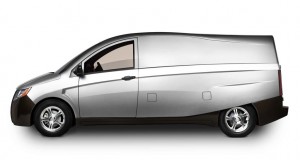
The Bright IDEA plug-in truck was designed to deliver 40 miles on battery, 36 mpg on gas -- and target a segment that generated nearly 1 million annual sales.
Ambitious electric vehicle maker Bright Automotive, which initially lured in the financial support of General Motors, has pulled the plug, the latest casualty in the shake-out of the still-emerging battery-car market.
Bright blames its demise on its failure to secure a Department of Energy loan needed to bring a planned plug-in hybrid delivery van to market.
The failure of the suburban Detroit start-up comes months after the collapse of Aptera, a California electric vehicle wannabe that had hoped to market an aircraft-like battery-electric vehicle. Like Bright, it had failed to secure the necessary financing to translate its plans into production.
Critics contend the nascent battery car industry is in danger of short-circuiting as the DoE reins in a once lavish program to provide funding for an array of battery car programs. The government has provided some support to a handful of makers, including established automotive giants Ford and Nissan, as well as some start-ups, notably California’s Tesla Motors and Fisker Automotive.
But in the wake of conservative Republican opposition that followed the collapse of Solyndra, a solar cell maker that went bankrupt despite a large DoE loan, the administration has all but put the energy loan program on hold. Next Auto, based in San Diego, also withdrew a loan application in recent months, forcing it to abandon its manufacturing efforts. And Fisker is now frantically racing to line up alternatives as the DoE demands it renegotiate its $528 loan after missing several key targets.
Fisker claims it is meeting some success attracting private investors and promises to complete the planned 2013 launch of its second product, codenamed Project Nina. But earlier this week the maker announced it was replacing founder Henrik Fisker as CEO with former Chrysler chief Tom LaSorda.
As for Bright Automotive, it had generated some financing, notably a $5 million investment from General Motors, but failed to receive its own, sought-after $450 million DoE loan after a three-year wait – and an earlier agreement to reduce the request to $314 million. According to Bright CEO Ruben Munger, the federal agency kept finding new hurdles to put in front of his company.
“Each new letter,” Munger wrote to Energy Sec. Stephen Chu, “arrived with more onerous terms than the last.” Munger pointedly noted that Bright’s application had been under review for 1,175 days, lamenting, “That is a record for which no one can be proud.”
Former Fisker CEO Henrik Fisker – now the maker’s executive chairman – expressed similar concerns in an interview with TheDetroitBureau.com when asked why it was taking so long to renegotiate that firm’s DoE loan.
Like many of its competitors, Bright initially hoped to produce a battery-based passenger car. But the maker later modified plans, officials telling TheDetroitBureau.com they saw a bigger opportunity – at least initially – in focusing on fleet vehicles, such as the midsize delivery truck the maker decided to develop. It was to be a plug-in hybrid that could handle most daily chores on battery power alone. But for longer runs it would be able to automatically fire up a small internal combustion engine, obviating so-called “range anxiety.”
The Energy Department’s loan program was originally allocated $25 billion but has so far provided potential manufacturers with $8 billion. Originally conceived to support Pres. Barack Obama’s goal of putting 1.5 million battery cars on the road by 2014, the program was intended to support high-risk efforts. But under fire from the GOP, supports lament, it has become increasingly risk-averse.
The DoE declined to comment directly on Bright’s concerns – but in a prepared statement it noted, “We understand that this is a difficult day for Bright Automotive and their workers. Over the last three years, the department has worked with the company to try to negotiate a deal that supported their business while protecting the taxpayers. In the end, we were not able to come to an agreement on terms that would protect the taxpayers.”
